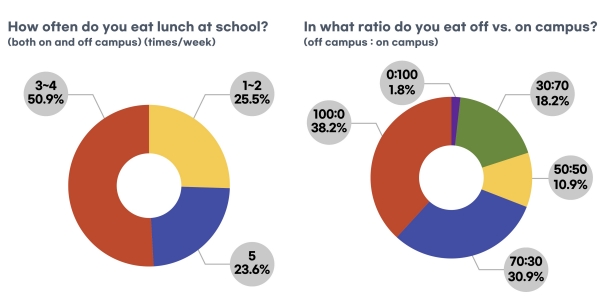
Spending a semester with classes fully in person, many Ewha students have expressed difficulties in having their meals. Recent postings on the school’s online community criticized the lack of choice in school cafeterias as well as the low quality yet high- priced food. On the other hand, students also faced difficulties when visiting restaurants on the Ewha main street as they are always full or run out of ingredients due to the crowd during lunch hours.
When Ewha Voice asked a group of freshmen from the Division of International Studies, students replied that they usually have three to four lunch meals a week at school, mostly at restaurants off campus.
“It is difficult to make use of the school cafeterias as they are usually not in the foot traffic of my lecture rooms,” one student said. “Also, it is hard to find cafeterias or restaurants inside school that match the taste of the whole friend group, as there is only a narrow range of choices.”
Another student emphasized that it is difficult to get information about school cafeterias as a foreign student, and she did not feel the need to seek for school cafeterias as there are cheaper options outside school.
When interviewing a group of students from the College of Engineering, the number of lunch meals they have at school varied from one to four times a week. Due to the series of lectures that run through lunch hours with only short 15-minute breaks in between, students are busy moving from one lecture room to another, making it difficult to have lunch anywhere other than through simple meals at the Ewha Coop in the Asan Engineering Building. Also, the fact that the engineering buildings arerelatively far away from the main gate and other school buildings made it more difficult to have quality meals.
“The clashes between the school timetable and the serving hours also makes it difficult to make use of the school cafeterias,” said a student who wished to stay anonymous. “The cafeteria at the engineering building is too small compared to the large number of students, and the short opening hours with long waiting time makes it even more inconvenient for busy students.”
To look into this problem, Ewha Voice conducted a survey of 110 Ewha students from Nov. 19 to Nov. 28. 50.9 percent of the respondents had lunch at school three to four times a week, with 23.6 percent having lunch at school five times a week. 38.2 percent of the respondents replied that they usually had lunch at restaurants around the Ewha main street area, with 30.9 percent replying that they ate at restaurants near school and school cafeterias at a 70 to 30 ratio.
Students reported that they tend to eat lunch at restaurants off campus as there is a wider range of choice in the menu despite the high prices of food and long queues. They expressed that although the prices are reasonable, the lack of choice and insufficient quality of the menus stopped them from choosing to eat at school cafeterias.
Anonymous comments related to the issue showed the respondents’ further varied opinions.
One noted, “It is difficult to have sufficient meals when coming to school as it takes too much time to eat off campus, and the menus at the school cafeterias are limited.”
Another said, “School cafeterias currently lack the ability to accommodate a large number of students and have options limited to Korean food menus. I would like to see Western food options every now and then, and it would be easier to make use of school cafeterias if the locations, opening hours, and prices are properly informed and promoted.”
Ewha Voice also heard from restaurants in the Ewha main street about the issue. The fact that it was not easy to contact most restaurants during weekdays due to the crowd of customers, and some restaurants replied it was difficult to even take part in a short interview, showed the popularity of restaurants around the area.
Momiji Sikdang, a Japanese fusion restaurant near the Sinchon station (railroad) and Ewha Womans Univ. station (line 2) area, expressed a significant increase of customers since September, when the fully in person semester started.
“Although it is difficult to calculate the exact number of increased customers due to the relocation of our restaurant, I can certainly say that there have been more customers compared to March,” the owner of Momiji Sikdang said. “From 11:30 a.m. to 1 p.m., which we consider as the lunch hours, there are over ten groups of students waiting in line with their friends. This is definitely a crowd, compared to the usual three to four groups waiting in line.”
The owner of Momiji Sikdang stated that their efforts and preparations for the crowd of students included the introduction of kiosks and increasing the amount of food placed at the self-serve salad bars for a high turnover ratio. Despite these preparations, the restaurant still faces difficulties in terms of workforce when there are much more customers than expected, and therefore is continuously working to alleviate the problem and meet the need of more customers.

